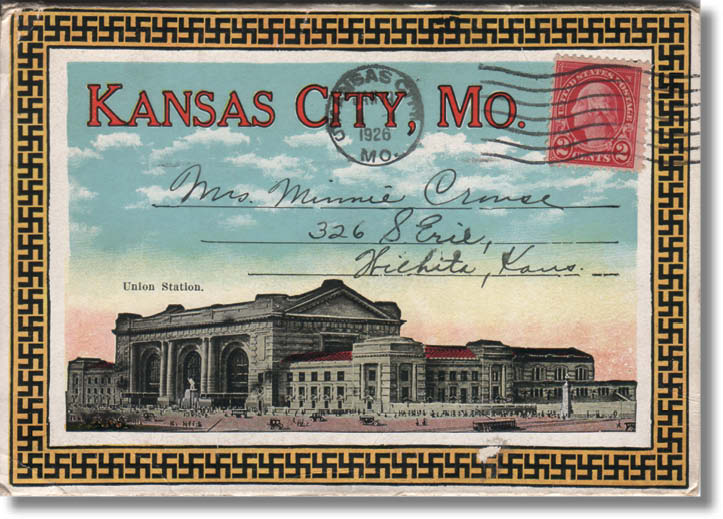By Michael Bushnell
Northeast News
March 30, 2016
This week we feature a souvenir postcard published by long-time postcard publisher Max Bernstein in 1921. It comes from a souvenir folder of 16 postcards. Souvenir folders originated around 1910 and became a popular way for postcard publishers to showcase a number of views of a given town or attraction while maintaining a single mailing piece.
Some of the more modern postcard folders feature perforated lines between the cards for tearing off so buyers have the option of sending a single message on the back of a standard postcard.
This week’s card was mailed to Mrs. Mamie Crouse, residing at 326 S. Erie in Wichita, Kan. Judging by the handwritten signature on the inside flap, Mrs. Crouse probably sent this to herself. This card depicts Union Station, and some of the other views in this folder included the Hotel Muehlebach, Convention Hall, the Bear Pits in the Swope Park Zoo and the “Peristyle” on Gladstone Boulevard — now known as the Concourse.
The border of this folder is a series of black swastikas on a yellow background. For centuries, the swastika held a positive meaning and was used by numerous cultures – American Indian, Chinese, Japanese, Indian and southern European – to represent life, sun, power, strength and good luck. Artifacts from ancient Troy show that the swastika was a commonly used symbol as far back as 1,000 BCE. Often referred to as “the oldest known symbol,” the word “swastika” comes from the Sanskrit svastika: su, meaning “good,” asti meaning “to be,” and ka as a suffix.
Even in the early 20th century, the swastika was still a symbol with positive connotations. For instance, it often adorned cigarette cases, postcards, coins and buildings. During World War I, the swastika could even be found on the shoulder patches of the U.S. Army’s 45th Division; it was painted on the planes of the Finnish Air Force until after World War II.
Since Adolph Hitler adopted the symbol for his Nazi Party flag, however, the symbol has taken on a more evil connotation, despite its almost 3,000 years of signifying good luck and good fortune.




















